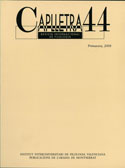Posició i funció dels connectors «a més (a més)», «però» i «doncs» en català escrit i oral
DOI:
https://doi.org/10.7203/caplletra.44.4805Paraules clau:
Connectors, Oral Language, Distribution Resum
Resum
This article is an approach to the study of the syntactic positions that parentetic connectors take in oral discourse in Catalan –in sentential segments particularly– based on the analysis of three connectors with different meanings: «a més a més» (additive), «però» (contrastive) and «doncs» (consecutive). The methodology used is contrastive: firstly, the positions in which all three linking words stand in a corpus of written language (written press) are studied, and secondly, the results obtained are
compared with datum coming from an oral corpus constituted mainly of monologic texts. The comparison brings to light that conditions of production of oral modality (immediateness, lack of planning, etc) force to resorting to own strategies to guarantee
the connection of the text, like reinforcing a conjunction with a parentetic connector («a més a més»), to promote the conjunctive use of a connector («però») and to assure the connection among subject-rheme («doncs»)
 Descàrregues
Descàrregues
Descàrregues
Publicades
Com citar
-
Resum559
-
PDF125
Número
Secció
Llicència
L’autor o autora que adrece un treball a la redacció de Caplletra perquè siga publicat ha de ser la persona titular legítima dels drets d'explotació. La legitimació per a la publicació del treball ha d’incloure també les imatges, les taules, els gràfics i altres materials que puguen complementar el text, amb independència de si n'és l'autor o autora.
Copyright. Quan publica el treball en la revista, l'autor o autora cedeix a Caplletra. Revista Internacional de Filologia els drets d'explotació (reproducció, distribució i comunicació pública), tant per a l'edició impresa en paper com per a la versió electrònica, que serà accessible mitjançant la xarxa Internet.
Tots els treballs publicats en Caplletra es troben sota una llicència Creative Commons del tipus Reconeixement-NoComercial-SenseObraDerivada 4.0.
RESPONSABILITAT
Caplletra. Revista Internacional de Filologia no s'identifica necessàriament amb els punts de vista mantinguts en els treballs que publica.
Caplletra. Revista Internacional de Filologia declina tota responsabilitat derivada de qualsevol vulneració eventual dels drets de propietat intel·lectual que poguera ser duta a terme pels autors o autores.






